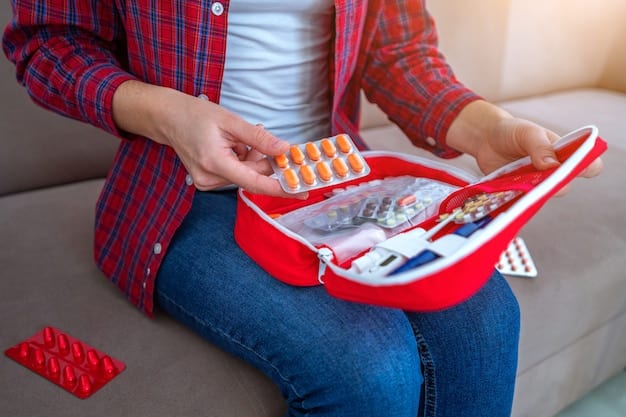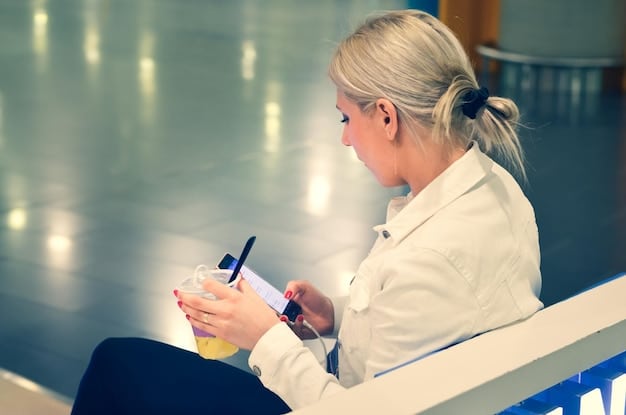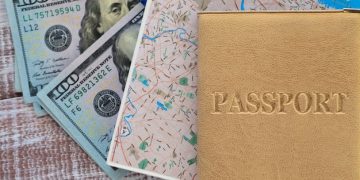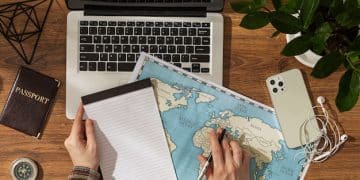How to Travel with Medications: Your 2025 Guide

Traveling with medications requires careful planning to ensure you have what you need, comply with regulations, and avoid any disruptions to your health regimen during your 2025 trips, both domestically and internationally.
Planning a trip in 2025? Don’t let medication concerns add stress to your journey. Our comprehensive guide, how to travel with medications, offers practical tips and essential information to ensure a smooth and healthy travel experience.
Planning Ahead: The Key to Stress-Free Travel with Medications
Traveling, whether for business or leisure, can be an exciting experience. However, if you require medication, it’s crucial to plan ahead to ensure a smooth and worry-free trip. Proper planning not only helps you avoid potential health complications but also ensures you comply with travel regulations.
Consult Your Healthcare Provider
Before you even book your flights, schedule a consultation with your healthcare provider. This is a critical step in preparing to travel with medications.
- Discuss your travel plans, including the duration of your trip and any potential changes in your routine.
- Ask for a complete list of your medications, including generic and brand names. This list can be invaluable if you need to seek medical attention while abroad.
- Obtain copies of your prescriptions.
Check Medication Regulations
Different countries have varying regulations regarding the entry of medications. It’s your responsibility to understand these rules well in advance of your departure date.

Essential Documentation: Ensuring Compliance
Having the right documentation is paramount when traveling with medications. These documents serve as proof that your medications are legally prescribed and necessary for your health. They also help you navigate customs and security checkpoints more efficiently.
Imagine the frustration of being held up at customs because you can’t verify the legitimacy of your medications. Here’s how to avoid that:
Prescription Copies
Always carry copies of your prescription for all your medications. These copies should be clear and easy to read.
Doctor’s Letter
A letter from your doctor can provide additional validation for your need to travel with your medications, especially if you are carrying controlled substances or large quantities.
- The letter should include your name, your doctor’s contact information, a list of your medications (both generic and brand names), dosages, and a statement of your medical condition.
- Ensure the letter is printed on official letterhead and signed by your doctor.

Packing Your Medications: Keep Them Safe and Accessible
How you pack your medications is just as important as having the right documentation. Proper packing ensures that your medications remain safe, accessible, and in compliance with airline regulations. This section will guide you through the best practices for packing your medications, so you can avoid any unnecessary hassles during your travels.
Here are some key tips.
Carry-On vs. Checked Baggage
Always pack your medications in your carry-on baggage. This ensures that you have immediate access to them during your flight and avoids the risk of losing them if your checked baggage is delayed or lost.
Original Packaging
Keep your medications in their original packaging with the prescription labels clearly visible. This makes it easier for security personnel to identify the medications and verify their legitimacy. It also provides important information about dosage and administration.
Pill Organizers
While pill organizers can be convenient, it’s best to supplement them with the original packaging and prescription copies. If you choose to use a pill organizer, make sure it is clearly labeled and that you have the necessary documentation to support its contents.
Navigating Airport Security: Tips for a Smooth Experience
Airport security can be a stressful part of traveling. Knowing what to expect and how to prepare can make the process smoother, especially when you are traveling with medications.
Here’s what you should consider.
Inform TSA Officers
When going through airport security, inform the Transportation Security Administration (TSA) officer that you are carrying medications. Be prepared to present your prescription copies and doctor’s letter if requested.
Liquid Medications
Liquid medications are subject to the TSA’s 3-1-1 rule, which limits the quantity of liquids you can carry in your carry-on baggage.
- However, there is an exception for medically necessary liquids. You are allowed to carry larger quantities of liquid medications as long as you declare them to the TSA officer and have the necessary documentation.
- Place liquid medications in a separate bag for easy inspection.
Medication Cooling
If your medications require refrigeration, such as insulin, you are allowed to bring ice packs or gel packs to keep them cool.
Traveling Internationally: Country-Specific Considerations
International travel adds another layer of complexity when it comes to traveling with medications. Regulations can vary significantly from one country to another, so it’s essential to do your homework before you go.
Research Destination Regulations
Before traveling to a foreign country, research the specific regulations regarding the medications you intend to bring. Contact the embassy or consulate of the destination country to obtain the most up-to-date information.
Controlled Substances
If you take controlled substances, such as opioids or stimulants, be aware that many countries have strict regulations regarding their importation.
Language Barriers
If you need to seek medical attention while abroad, language barriers can pose a challenge. To mitigate this, consider having your medication information translated into the local language. This can be particularly helpful when dealing with healthcare professionals who may not speak English.
Common Mistakes to Avoid When Traveling with Medications
Even with meticulous planning, it’s easy to make mistakes when traveling with medications. Being aware of these common pitfalls can help you avoid unnecessary stress and complications during your trip. This section will highlight some of the most frequent errors travelers make and provide tips on how to prevent them.
Here are some of the commonest mistakes.
Not Carrying Enough Medication
One of the most common mistakes is not carrying an adequate supply of medication to cover the entire duration of your trip, plus extra for unforeseen delays.
Ignoring Storage Requirements
Some medications require specific storage conditions, such as refrigeration or protection from light. Failing to adhere to these requirements can compromise the efficacy of your medication.
- If your medication needs to be refrigerated, use a cooler with ice packs to maintain the appropriate temperature.
- Protect light-sensitive medications by keeping them in their original packaging or using opaque containers.
Neglecting Time Zone Adjustments
Crossing time zones can disrupt your medication schedule. It’s essential to plan how you will adjust your medication timings to align with the new time zone.
| Key Point | Brief Description |
|---|---|
| 🩺 Consult Doctor | Discuss travel plans and get necessary prescriptions. |
| ✈️ Pack Carry-On | Always keep medications in your carry-on for easy access. |
| 🔒 Original Packaging | Maintain medications in original labeled containers. |
| 🛂 Security Check | Inform TSA officers about your medications during security checks. |
Frequently Asked Questions
▼
You should carry copies of your prescriptions, a letter from your doctor stating your medical condition and the necessity of the medications, and keep the medications in their original packaging with prescription labels.
▼
Yes, you can carry liquid medications exceeding the standard 3.4-ounce limit in your carry-on if they are medically necessary. Inform TSA officers and present documentation verifying the need for these medications.
▼
Plan your medication schedule according to the new time zone gradually. Consult your healthcare provider for specific advice on adjusting dosages and timings to avoid disruptions.
▼
If you lose your medication, contact the local embassy or consulate, visit a local healthcare provider for a new prescription, and use your prescription copies and doctor’s letter to facilitate the process.
▼
Some countries have restrictions on certain medications, especially controlled substances. Research the regulations of your destination country, and consult your doctor about possible alternatives if needed.
Conclusion
Traveling with medications requires careful planning and attention to detail, but with the right preparation, you can ensure a safe and stress-free journey. By consulting your healthcare provider, securing necessary documentation, and understanding travel regulations, you can confidently manage your health needs while exploring the world. Safe travels!





